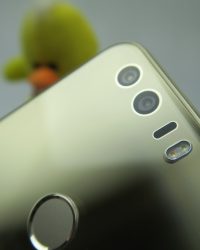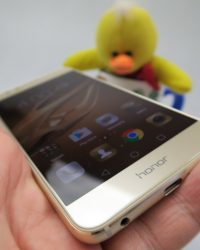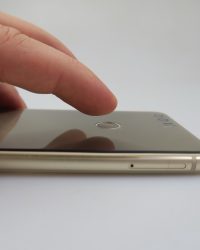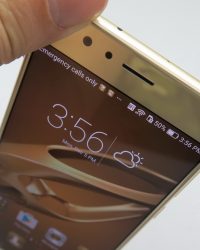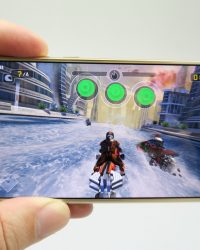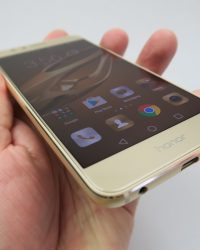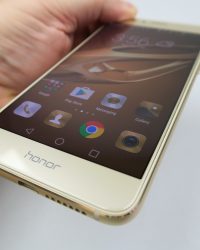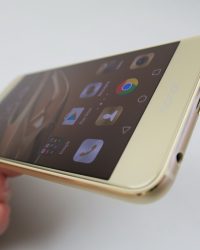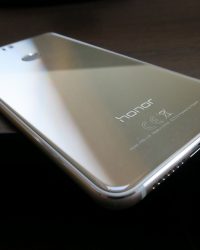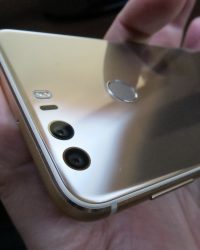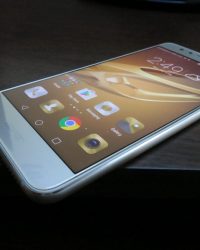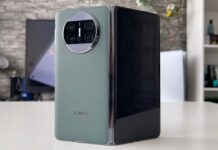It’s been a while since we last posted a review so I say we kickstart 2017 in style with a deep analysis of the Huawei Honor 8 handset. We’re familiar with all the Huawei lineup, having reviewed the P9, P9 Plus, Honor 7, Honor 5X and the Mate and Nova models over the past year. However, the Honor 8 stands out because it adopts a glass back panel, something that Huawei hasn’t been doing in 2016 and also a dual camera. Launched in the summer of last year, this model is priced at $400 in the 32 GB version.
We have the 64 GB model in a gold color hue and it’s also available in white, black or blue. Design-wise, we get dual 2.5D glass panels, one at the back and one at the front, with rounded edges and a metal frame to keep them together. This is a reasonably slim device, at 7.45 mm in thickness, not very far from the 7 mm Huawei P9. It also weighs a reasonable 153 grams, which is a bit hefier than the ASUS ZenFone 3’s 144 grams.
It fits great in the hand, offers good grip and a nice button feedback and I mean ALL buttons, including the new one from the back side, with the fingerprint scanner and all. Speaking of the back side, that glass surface is a fingerprint magnet, but it catches the light in a very nifty way, which actually reminds me of the Xperia Z5 a bit.
The build is solid and this phone is prettier than any other Honor or Mate model from Huawei (till the Mate 9 came). I’d say it’s also better looking than the Nova units. Moving on to the display, this one is a 5.2 incher with a LTPS panel (IPS LCD), that has a 16:9 aspect and Full HD resolution. It’s got 96% NTSC color gamut and very narrow bezels.
We tested its abilities with the aid of the preinstalled video player, that offers options for DTS acoustics and play speed. The viewing experience was solid, with good brightness and contrast, wide view angles, but the black wasn’t deep. Colors are also too vivid, I think. Pixels are of the RGB Stripes variety and we also used the luxmeter, measuring 420 LUX units, which is pretty good, but doesn’t break records.
At least it beats the iPhone 7 Plus by 2 LUX and the Huawei Nova Plus, but also scores below the iPhone SE and Huawei Honor 5X. Settings include font size, brightness, color temperature (cold, warm or a round meter to choose the hue from), as well as Eye Comfort, that removes the hue of blue from the screen for a better experience. It’s an OK display overall.
Now let’s talk about the hardware specs! We’ve got a 2.3 GHz octa core CPU here, a HiSilicon Kirin 950, that feels familiar, because we already saw it in action on the Huawei Mate 8 and the MediaPad M3 tablet. It’s accompanied by 3 or 4 GB of RAM, plus the Mali T880 MP4 GPU. Huawei also offers 32 or 64 GB of storage and a microSD card slot.
The device doesn’t have one trace of lag and it comes with a fluid UI, plus apps that start up pretty fast. Riptide GP Renegade also runs without a hassle and the graphics look great. I did experience some overheating around the device’s edges though. We also did benchmark tests and we achieved a result in Quadrant higher tha the one of the Huawei P9 Plus, while also surpassing the Nexus 6P in AnTuTu, but we scored lower than the Mate 8 there.
In GeekBench 4 we even surpassed the Snapdragon 821 based ZenFone 3 Deluxe, at least in the single core sub test and the Google Pixel XL in the multi core one. Performance is good and the temperature test revealed 38.6 degrees Celsius after running the benchmark GFXBench and 36.8 degrees after running Riptide GP Renegade, so no overheating, at least in these tests.
We proceeded to do a battery test, using the integrated 3000 mAh unit with Smart Power 4.0 tech. On paper we are being promised 1.77 days of normal use, or 1.22 days of heavy use, or maybe 10 hours of video playback with no Internet. Fast charging is done at 9V and 2A, taking the device to 47% in 30 minutes. The video playback time we achieved in our test was 7 hours and 40 minutes, which is rather underwhelming to be honest. It only beats the Honor 7, the predecessor by 5 minutes, but at least it also beats the Huawei P9.
It scored below the Huawei Nova by 3 hours and the P9 Plus by 3 hours too. In PCMark we did a little better, with 7 hours and 7 minutes, surpassing the Huawei G8 and Honor 5X, but also being below the Nova unit by 2 hours+. Charging is solid, at 1 hour and 44 minutes, even beating the Galaxy S7 in the process. Battery options are typical for a Huawei, including WiFi on in sleep mode, closing excessively power using apps, ROG Power Save that makes the screen 720p and One Touch Optimization.
There’s also Power Plan with the modes Performance, Smart and Ultra Power Save and in the end it feels like a pretty mixed battery. Moving on to acoustics, we’ve got a 7 hole speaker at the bottom and a typical EMUI music player, sans equalizer. We do get DTS acoustics and no bundled headphones, on our test unit at least.
The listening experience did involved a pretty loud volume, clear sound, good strings, OK voice rendering, but it could have used more bass. At least there was no distortion. We did a decibelmeter test and achieved 81.3 dBA at both the front and back with our audio sample and 86.1 dBA when we ran the game Riptide GP Renegade, both solid results.
The latter one has us beating the Honor 7 by 5 decibels and also the Nexus 6P, which is not bad. There’s no FM radio here, just so you know. Now let’s discuss the dual back camera, which I have to mention does NOT include Leica technology. There two 12 MP sensors here, one color and one monochrome, a dual tone flash, laser focus, hybrid AF and F/2.2 aperture.
Upfront there’s an 8 MP selfie shooter, with F/2.4 aperture and 1.4 micron pixels. The camera app starts up fast, has a pretty OK focus speed and fluid zoom, plus it takes the pics fast. The UI is basically the same as on the Huawei P9 Lite, plus the whole Bokeh option thing, letting you focus on the foreground and background before and after the shot.
There are also effects and the following capture Modes: Beauty, Beauty Video, HDR, Time Lapse, Audio Note, Pro Photo, Pro Video, Panorama, Light Painting, Watermark , Video, Good Food and Night Shot, as well as Slow Motion and Document Scan. The Pro mode offers extra functions, like white balance, focus, exposure, shutter, ISO and metering. Finally you can set up object tracking, saturation, contrast and brightness.
Getting to the gallery of shots taken during the day, we had a cloudy mid December day on our hands, but we achieved great colors, nice clarity and no blur whatsoever. We did take some nice selfies too, but no on the level of a Huawei Nova though. Closeups and the whole bokeh thing were great, not far from what the P9 and iPhone 7 Plus are offering.
Details were solid in landscape shots and the panorama was quite detailed, at 13.184 x 2304 pixels. It was clear and crisp, too. Of course, these are 12 MP cameras, so zooming into shots inevitably reveals detail loss. The HDR was rather good, but also a bit on the dark side and I liked the texture of those colorful toys in the park. I also enjoyed the ability to play with the focus, the brightness and dynamic range of pics.
We even caught a nice sunset on camera. I’d place this phone on equal terms of quality with the ASUS ZenFone 3 models, the Huawei Novas and the Galaxy A 2016 models. It feels only slightly below the Huawei P9 and a bit below the Nexus 6P, but it’s clearly above the Huawei Honor 7. Strangely, the Honor 6 Plus still holds its own even today and even compared to the Honor 8, because that one also had dual cameras.
As far as low light photo capture goes, we did register some “fog”, but the lighting was OK and the clarity was quite fine, with those small wooden cabins. Street lights had reasonably sized halos and there was no strange violet or blue hue to annoy us. The flash felt rather poor, making the image a bit washed out and too white. The square where we took the next series of shots had a bit too much yellow, but the clarity was great.
Some moved shots happened at first, but then it was all perfect. In the end this can’t be compared to the excellent Huawei Mate 8, that was a low light capture champion and it’s also below the ASUS ZenFone 3 level, but for an Honor model it’s OK and also superior to the Honor 7 still. Videos were shot in MP4 format, in Full HD at 30 or 60 FPS, with a 17 or 35 Mbps bitrate.
The exposure change was quite OK, but the zoom was a bit on the poor side. Colors were nicely calibrated and the digital stabilization was more of a so-so affair. I felt that the image was a bit too shaky, even for a midrange phone, but still an upper midranger. The best thing was the microphone, that was able to do its job with no problem, distortion and faced the wind fine.
Still, looking back at the way the Honor 7 handled itself on a sunny day, the Honor 8 certainly bests it, in clarity and dynamic range at least. It still remains mid level filming and doesn’t break any record for sure, scoring both below the ASUS ZenFone 3 models and the Galaxy A 2016 ones. Low light videos were rather pleasant to watch, in artificial lighting conditions and the microphone was once again very good.
Sadly, when we switched to the square with the yellow lighting things got very foggy. It’s still December and winter, so that may also count. Low light capture feels like an area where the Honor 8 didn’t step up from the Honor 7. With that said and done, we go to the browser, in this case the preinstalled Chrome, that loads up pretty fast and also has rather solid benchmarks.
On the input front, the keys of the virtual keyboard are well spaced and there’s also Swype support. Now let’s see how connectivity is handled! Huawei Honor 8 offers an USB Type C port, 4G LTE Category 6, NFC, infrared, OTG support and Bluetooth 4.2, plus VoLTE. It’s a dual SIM device, with the first slot being a nano SIM and the second one also doubling as a microSD card slot.
There’s dual microphone noise cancelling here and the list of connectivity options goes on with WiFi a/b/g/n/ac, GPS, Glonass. The infrared sensor is able to connect to up to 232.000 appliances, so that’s nice. Calls are loud and clear, crisp too and the signal was good. The dialer offers features like Harassment Filter, Speed Dial and a Pocket Mode.
We also did a SpeedTest and achieved 220 Mbps in download via WiFi and 24 Mbps in upload, both good results, then we went to 4G and achieved 84 Mbps in download and 47 Mbps in upload, also good results. Now we have reached the software part of the review, where we find Android 6.0 Marshmallow running with EMUI 4.1 on top. It’s a very familiar experience, the very same one from the Huawei P9 Lite.
We get a flat UI, no app drawer, no gloss and no flashy colors. Multitasking is done with the aid of a horizontally scrolling collection of thumbnails, one for each opened app. Swiping down on a homescreen lets you perform searches, while the dropdown section includes notifications shown as a timeline, plus Quick Settings. Pinch he homescreen and you’ll get options like wallpapers, widgets, transitions, layout and alignment.
Finally, we get to the Settings area, where there’s the Homescreen Style, Nav Bar options, floating dock, Smart Key (physical button at the back used to open a variety of apps and functions you can customize), plus the already famous Knuckle gestures, letting you draw bits of a screenshot on the screen and perform it. We’ve got One Hand UI, voice control, a Gloves Mode and Do Not Disturb too.
The fingerprint scanner at the back has a 7 step setup, it’s accurate but slow and it lets you take a picture, answer a call and browse pictures by swiping on it. As usual we count the preinstalled apps and the count is up to 48 here, which are quite a few, with only 8 being uninstallable, so we can call it bloatware with ease. Among the preinstalled apps we find Themes, Phone Manager, Health, Smart Controller, Facebook and Twitter.
And now it’s time for the verdict!
Here are the Pros:
- pretty design
- good display
- nice performance
- solid acoustics
- quality pictures for a midrange phone
- extra button is always welcome and so is the infrared sensor
And the Cons:
- fingerprint magnet at the back
- hot edge in games
- battery should be a bit better
- lots of preinstalled apps
- the dual camera doesn’t do much extra aside from Bokeh
- not a big jump from Huawei Honor 6 Plus
In the end, this phone is one for people who want a case made of more glass than metal, but also those who want a media phone. This is usually a phone good for watching movies, listening to movies and taking some pictures in important moments of your life. The battery is reliable, but not record breaking and looking at all the features, it’s clear that this is an upgrade from the Honor 7, particularly in the camera area.
One place where the phone doesn’t shine is low light filming, but at least the microphone is good. The phone is priced at $400.
























